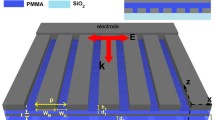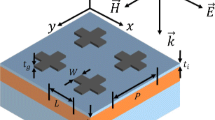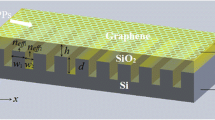Abstract
A novel nanoscale structure for high sensitivity sensing which consists of a graphene nanoribbon waveguide coupled with detuned graphene square-nanoring resonators (GSNR) based on edge mode is investigated in detail. By altering the Fermi energy level of the graphene, the plasmon-induced transparency (PIT) window from the destructive interference between a radiative square-nanoring resonator and a dark square-nanoring resonator can be easily tailored. The coupled mode theory (CMT) is used to show that the theoretical results agree well with the finite difference time domain (FDTD) simulations. This nanosensor yields a ultrahigh sensitivity of ∼2600 nm/refractive index unit (RIU) and a figure of merit (FOM) of ∼54 in the mid-infrared (MIR) spectrum. The revealed results indicate that the Fermi energy level of the graphene and the coupling distance play important roles in optimizing the sensing properties. Our proposed structure exerts a peculiar fascination on the realization of ultra-compact graphene plasmonic nanosensor in the future.




Similar content being viewed by others
References
Fleischhauer M, Imamoglu A, Marangos JP (2005) Electromagnetically induced transparency: optics in coherent media. Rev Mod Phys 77:633–673
Longdell JJ, Fraval E, Sellars MJ, Manson NB (2005) Stopped light with storage times greater than one second using electromagnetically induced transparency in a solid. Phys Rev Lett 95:063601
Yannopapas V, Paspalakis E, Vitanov NV (2009) Electromagnetically induced transparency and slow light in an array of metallic nanoparticles. Phys Rev B 80:035104
Kekatpure RD, Barnard ES, Cai W, Brongersma ML (2010) Phase-coupled plasmon-induced transparency. Phys Rev Lett 104:243902
Duan X, Chen S, Cheng H, Li Z, Tian J (2013) Dynamically tunable plasmonically induced transparency by planar hybrid metamaterial. Opt Lett 38:483–485
Liu G, Zhai X, Wang LL, Wang BX, Lin Q, Shang X (2016) Actively tunable fano resonance based on a T-shaped graphene nanodimer. Plasmonics 11:381–387
Shang X, Zhai X, Li X, Wang L, Wang B, Liu G (2016) Realization of graphene-based tunable plasmon-induced transparency by the dipole-dipole coupling. Plasmonics 11:419–423
Xiao S, Wang T, Liu Y, Han X, Yan X (2016) An Ultrasensitive and multispectral refractive index sensor design based on quad-supercell metamaterials. Plasmonics. doi:10.1007/s11468-016-0248-8
Yang X, Yu M, Kwong DL, Wong CW (2009) All-optical analog to electromagnetically induced transparency in multiple coupled photonic crystal cavities. Phys Rev Lett 102:173902
Wang B, Wang T, Tang J, Li X, Zhu Y (2014) A dynamic and ultrafast group delay tuning mechanism in two microcavities side-coupled with a waveguide system. J Appl Phys 116:133101
Han X, Wang T, Li X, Zhu Y (2015) Dynamically tunable by kerr effect multichannel filter based on plasmon induced transparencies at optical communication range. Plasmonics. doi:10.1007/s11468-015-0102-4
Zia R, Schuller JA, Chandran A, Brongersma ML (2006) Plasmonics: the next chip-scale technology. Materials today 9:20–27
Grigorenko AN, Polini M, Novoselov KS (2012) Graphene plasmonics. Nat Photonics 6:749–758
Nikitin AY, Guinea F, Garca-Vidal FJ, Martn-Moreno L (2011) Edge and waveguide terahertz surface plasmon modes in graphene microribbons. Phys Rev B 84:161407
Liu M, Yin X, Ulin-Avila E, Geng B, Zentgraf T, Ju L, Wang F, Zhang X (2011) A graphene-based broadband optical modulator. Nature 474:64–67
Liu M, Yin X, Zhang X (2012) Double-layer graphene optical modulator. Nano Lett 12:1482–1485
Ooi KJA, Chu HS, Bai P, Ang LK (2014) Electro-optical graphene plasmonic logic gates. Opt Lett 39:1629–1632
Tao J, Yu XC, Hu B, Dubrovkin A, Wang QJ (2014) Graphene-based tunable plasmonic Bragg reflector with a broad bandwidth. Opt Lett 39:271–274
Zhang L, Yang J, Fu X, Zhang M (2013) Graphene disk as an ultra compact ring resonator based on edge propagating plasmons. Appl Phys Lett 163114:103
Li HJ, Wang LL, Liu JQ, Huang ZR, Sun B, Zhai X (2013) Investigation of the graphene based planar plasmonic filters. Appl Phys Lett 211104:103
Xiao S, Wang T, Liu Y, Xu C, Han X, Yan X (2016) Tunable light trapping and absorption enhancement with graphene ring arrays. doi:10.1039/C6CP03731C
Bao Q, Zhang H, Ni Z, Wang Y., Polavarapu L, Shen Z, Xu Q H, Tang D, Loh K P (2011) Monolayer graphene as a saturable absorber in a mode-locked laser. Nano Res 4:297–307
Lu H, Liu X, Mao D, Wang G (2012) Plasmonic nanosensor based on Fano resonance in waveguide-coupled resonators. Opt Lett 37:3780–3782
Zafar R, Salim M (2015) Enhanced figure of merit in Fano resonance-based plasmonic refractive index sensor. IEEE Sens J 15:6313–6317
Huang Y, Min C, Dastmalchi P, Veronis G (2015) Slow-light enhanced subwavelength plasmonic waveguide refractive index sensors. Opt Exp 23:14922–14936
Li F, Jackson SD, Grillet C, Magi E, Hudson D, Madden SJ, Moghe Y, Brien C O, Read A, Duvall SG (2011) Low propagation loss silicon-on-sapphire waveguides for the mid-infrared. Opt Express 19:15212–15220
Lynch DW, Hunter WR (1998) Handbook of optical constants of solids. Academic, pp 653–657
Zeng C, Guo J, Liu X (2014) High-contrast electro-optic modulation of spatial light induced by graphene-integrated Fabry-Prot microcavity. Appl Phys Lett 105:121103
Zhang T, Chen L, Wang B, Li X (2015) Tunable broadband plasmonic field enhancement on a graphene surface using a normal-incidence plane wave at mid-infrared frequencies. Sci Rep 5:11195
Han X, Wang T, Li XM, Xiao SY, Zhu YJ (2015) Dynamically tunable plasmon induced transparency in a graphene-based nanoribbon waveguide coupled with graphene rectangular resonators structure on sapphire substrate. Opt Express 23:31945–31955
Xu Q, Wu MY, Schneider G F, Houben L, Malladi SK, Dekker C, Yucelen E, Dunin-Borkowski RE, Zandbergen H W (2013) Controllable atomic scale patterning of freestanding monolayer graphene at elevated temperature. ACS Nano 7:1566– 1572
Baringhaus J, Ruan M, Edler F, Tejeda A, Sicot M, Ibrahimi AT, Jiang Z, Conrad E, Berger C, Tegenkamp C, Heer W A (2014) Exceptional ballistic transport in epitaxial graphene nanoribbons. Nature 506:349–354
Han X, Wang T, Li XM, Liu B Y, He Y, Tang J (2015) Ultrafast and low-power dynamically tunable plasmon-induced transparencies in compact aperture-coupled rectangular resonators. J Lightw Technol 33:3083–3090
Lin Q, Zhai X, Wang L, Wang B, Liu G, Xia S (2015) Combined theoretical analysis for plasmon-induced transparency in integrated graphene waveguides with direct and indirect couplings. EPL 111:34004
Zhan S, Peng Y, He Z, Li B, Chen Z, Xu H, Li H (2016) Tunable nanoplasmonic sensor based on the asymmetric degree of Fano resonance in MDM waveguide. Sci Rep 6:22428
Shen Y, Zhou J, Liu T, Tao Y, Jiang R, Liu M, Xiao G, Zhu J, Zhou ZK, Wang X, Jin C, Wang J (2013) Plasmonic gold mushroom arrays with refractive index sensing figures of merit approaching the theoretical limit. Nat Commun 4:2381
Acknowledgments
The author Xicheng Yan expresses his deepest gratitude to his advisor Tao Wang for providing guidance during the whole project. This work is supported by the National Natural Science Foundation of China (Grant No. 61006045 and 61376055), and the Fundamental Research Funds for the Central Universities (HUST: 2016YXMS024).
Author information
Authors and Affiliations
Corresponding author
Rights and permissions
About this article
Cite this article
Yan, X., Wang, T., Han, X. et al. High Sensitivity Nanoplasmonic Sensor Based on Plasmon-Induced Transparency in a Graphene Nanoribbon Waveguide Coupled with Detuned Graphene Square-Nanoring Resonators. Plasmonics 12, 1449–1455 (2017). https://doi.org/10.1007/s11468-016-0405-0
Received:
Accepted:
Published:
Issue Date:
DOI: https://doi.org/10.1007/s11468-016-0405-0




